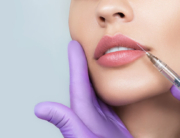Cosmetic plastic surgery and aesthetics have come a long way. Where years ago the only tool available to administer dermal fillers was the traditional sharp-ended needle, more recently the cannula has been used with great success and possesses a long list of benefits. Many patients now see the traditional needle as outdated, but it is important to understand that the needle and cannula both have their advantages and disadvantages, and that both can be used respectively in different circumstances and on distinct facial features for equally beneficial results. Let’s look at both the classic needle and cannula in more detail.
The Needle
The needle is more widely recognized by many as a common tool used in doctors’, surgeons’ and nurses’ offices. The needle has a sharp end or edge that easily pierces through any skin or tissue to deliver its antidote, or in this case, dermal filler. The needle will travel through any tissue to reach it’s destination. The filler travels through the shaft of the needle, and dispenses the filler through the end of the needle. This ensures that the filler travels precisely to the exact location, whether that be superficially or deep down through the various layers of tissue. While the advantage of using the traditional rigid needle does present itself in regards to precision, and is more beneficial in administering filler to certain areas of the face, it does come with a few disadvantages or limitations.
Due to its sharp edge, the needle does not discern between distinct layers of tissue, veins or arteries. Its sharp edge easily pierces and cuts through whatever stands in its way. For this reason, needles often will lend more bruising and swelling as the skin and body recover from punctures, resulting in more downtime.
The Cannula
There’s been a lot of hype regarding the use of cannulas in recent years, and this instrument’s beneficial traits certainly do not disappoint. From a distance, the cannula resembles the classic needle considerably. Upon a closer look, you’ll see that where the needle is sharp-edged, the cannula has a round blunt-ended tip. This blunt end can not pierce through any skin or layers, so when using it to inject filler, Dr. Adibfar would first need to use the classic needle to puncture the skin, and from there would use the cannula.
Due to its blunt end and inability to pierce tissue, the cannula (when inserted through the puncture hole) helps push tissue and other underlying structures away rather than cut through them, creating an alternative pathway that avoids any damage to arteries and veins. By pushing around tissues, the cannula reduces any chance of swelling or bruising, resulting in less discomfort and downtime. The dermal filler, like the classic needle, travels through the cannula’s more flexible shaft, but instead of delivering the filler through the cannula’s tip, is dispensed just under the blunt end around the sides of the cannula in a spray-like fashion. This also allows the cannula to deliver the filler to various areas via one single entry point for a smooth and even result. For extremely sensitive areas like the sides of the nose, lips and eyes, the cannula proves very efficient and beneficial. The cannula can also travel deep into fat pads as the needle would, except it wouldn’t cause any damage to veins. The reduced chance of bruising and swelling also means that patients are more likely to return to work faster than they would had they had to recover for a longer period from bruising and swelling. Because of the cannula’s ability to manipulate it’s way around underlying tissue, surgeons have found the use of cannulas in their practice very helpful in achieving optimal results with less damage and incurred downtime.
While as a patient, your first thought may be to dispose of all needles in favour of cannulas, it is still important to note that needles and cannulas do have their distinct set of advantages and limitations when it comes to specific applications and specific areas of the face. And while it’s vital to acknowledge the great benefit cannulas have in providing better results (with less downtime), in many cases, the classic needle still holds superior in certain, more precise applications.
Click here to learn more or to book a consultation with one of Toronto’s best board-certified cosmetic plastic surgeons, Dr. Adibfar.








Leave A Comment